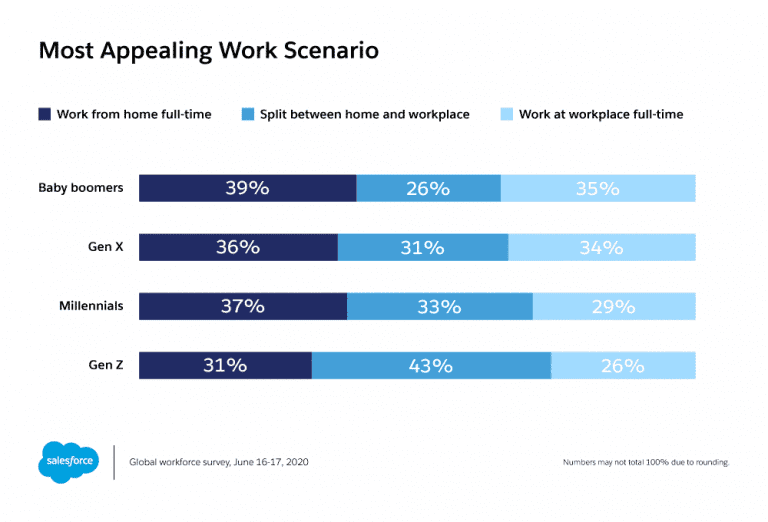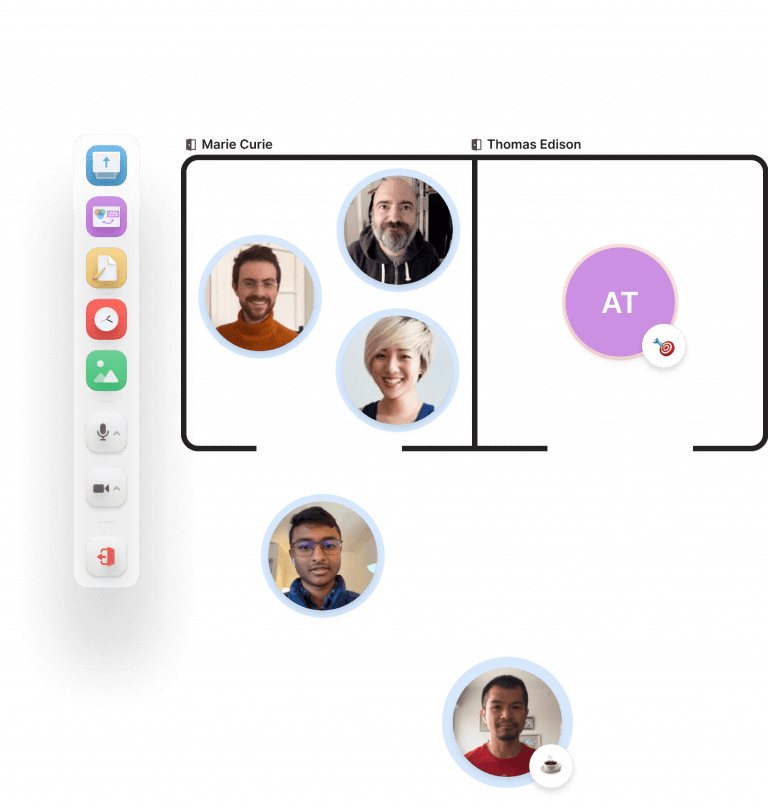A New Work Odyssey
8 Predictions for our Future Work and Workplace Experience
Grantley Morgan
Originally posted in February 2021
Beyond the looming permanence of hybrid workplaces and distributed teams, could Covid-19 catalyse a deeper reconstruction of work and workforces? Discover why I think the answer is yes, on a scale last seen during the aftermath of WW2. Change could be as radical as staffing agencies replacing universities as tertiary educators, contemporary talent guilds emerging as a counterweight to Big Tech, and a new taxation model built upon an individual rather than firm-based legislative framework.
Our journey to a new experience of work is only just getting started…
My 8 workplace experience trends at-a-glance:
- Work-at-home permanence
- Work anywhere, anytime
- Rise of Community Experience Managers
- A new relationship with data
- Outcome-based leadership and performance models
- Hybrid educators
- Talent “guilds”
- New taxation models
Introduction
Once-in-a-generation economic crises, particularly those caused by pandemics or major wars, have proven time over their propensity to catalyze widespread social change, including radical change in our relationship with work. Post-WW2, the devastating loss of life and capital combined with huge injections of state-spending to redefine the core tenets of society: radically transforming work, welfare and the class system. In the midst of the pandemic, it’s easy to see how Covid-19 has had and could still have a similarly wide-reaching impact.
By June 2020, the World Bank reported Covid-19 will be the deepest recession since WW2, having double the impact of the 2007-09 global financial crisis. However, the impact on jobs has been far greater; in late January, the ILO reported that globally 255m full-time jobs were lost in 2020, compared with employment levels in the fourth quarter of 2019 (an 8.8 percent reduction). Working hour losses are four times greater than during the global financial crisis. Whilst there can be no doubting the scale of impact, the effects are disproportionately spread (Latin America, Southern Europe and Southern Asia) and coverage of income-based support packages is uneven (disadvantaging independent workers, the young, women, and those in low-to-medium skilled jobs). The ILO predicts an uneven recovery, and one which risks compounding the rising inequality of recent years. (Source: ILO)
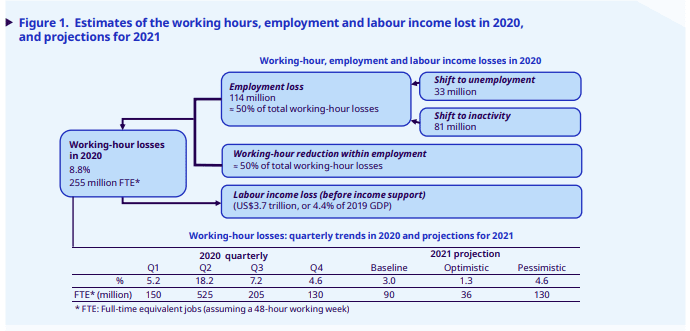
So extensive the economic and health impact, behavioral change is inevitable. Changes in worker preferences have already landed. In the UK, recent findings suggest that workers are reluctant to entirely forego their new found freedom from the commute and office, with only 7% preferring a return to the office full-time (source: Locatee). This comes despite the same survey indicating:
- Only 57% of respondents feel they are as productive working remotely
- Just 13% can manage and train teams as effectively
- 31% would accept a cash incentive of £10 or less per day to return to the office.
An indication enough of the clear need to carefully plan return-to-workplace programs, and tailor those to workforce segments. We’ll return to that in the next section.
Simultaneously, with the detachment of work from time and place comes behavior change in terms of how and where employers buy labor. Some commentators predict a new wave of globalization spurred by our enforced remote work experiment, this time impacting the far reaches of knowledge work (source: Toptal). Indeed, Harold James posits that the rise of telemedicine, remote medical care and de-urbanization could become additional globalizing factors. If those predicting that Covid-19 will deglobalize the world economy turn out to be wrong (as with past crises), pressures on the current construct of work will intensify. Steven Altman concludes that globalization will “bend not break”, which feels like a good direction to prepare for.
In the face of rapid social change reshaping work as we know it, governments continue to spend their way out of the crisis in an attempt to freeze job markets and halt the redundancy rate. This cocktail of economic, social and political variables spells an increasingly volatile future for our stretched social safety nets – and could risk those straining to breaking point in the medium term under current taxation models (as we switch our consumption and spending patterns to digital channels, we are inadvertently diverting tax revenues away from the very institutions intervening to help us). The good news is we are adding higher skilled jobs into developed economies; tempered by the fact the skills mismatch is growing and if left the meet the challenge alone, governments may not act quickly enough to plug it.
So, from the eye of a seemingly perfect storm, what changes to our work and workplace experience might remain, evolve and emerge over the next decade to provide a human-centered recovery?
Here to stay
Changes that will remain part of our new work odyssey
1. Work at home permanence
As mentioned, most employees state a preference for a hybrid relationship with home and office going forward. The desire for greater control over where we work isn’t a new driver of employee engagement, indeed Meister and Mulcahy wrote about the importance of the physical experience at work back in 2017. The difference now is the scale of the Covid-19 work experience we’re all living through. Adjusting behavior back to 5 days in the office is not a welcome expectation for many workers. Recent Salesforce research indicated that in the long-term, 64% of workers want to spend at least some hours at an office, store, factory, or another type of workplace, as opposed to working entirely remotely. The same research also showed up revealing generational differences in work scenarios, warning against a one-size-fits-all approach.
In an emerging new deal for workplace flexibility, 52% of employees – and 59% of millennials – stated their comfort sharing personal information like health data and contacts to keep the workplace safe. Employee health monitoring or daily wellness checks feature in the top 5 actions returning workers expect employers to take, along with reduced capacity and redesigned workplaces.
The future office could look much like Microsoft’s new campus in Israel, a space which amplifies employees’ ability to connect, collaborate and create. New office features could play to changing attitudes towards health monitoring technology (source: Bernard Marr) and enable employee choice over the type of space they are comfortable working in (here Microsoft’s ‘flexible grid’ concept offers much potential). Fora and MeetDistrict are charting towards new standards for safe, healthy co-working space.
However, there appears a disconnect between employee expectations for a safe return to work and executive action. Research published in January by Great Place to Work suggests that most executives are waiting on the vaccine with far fewer considering office space changes to comfort employees or inspire their trust and confidence. Such gaps could emerge as EVP deal-breakers if competitors invest in workplace changes at a faster rate.
In the same study, 52% of leaders suggested they are targeting a return to the workplace within 7-12 months. By investing in workplace experience now, we may be able to achieve that quicker and without reliance on the hugely variable pace of vaccine roll-out globally. Touchless workplace technology (e.g. Proxy) offers us an opportunity to win trust and inspire confidence in return to work arrangements, whilst reducing the disruptive impact of future pandemics.
2. Work anywhere, anytime
With our expectations around workplace flexibility seemingly now adjusted forever, companies will need to continue honing their digital workplace experience. Many IT departments have acted at tremendous pace to roll-out collaboration technologies like Microsoft Teams at an unprecedented scale. Many more will have negotiated numerous security concerns to enable seamless multi-device connectivity for the first time. And with the prospect of cyber attacks waged on corporate devices connected to weaker home and public networks, security will continue to be a priority.
It’s easy to see that a digital workplace experience will permeate more and more processes this year. By harnessing combinatorial technologies like Teams + Power Platform + Graph databases, we’ll be able to blend apps, automation and AI into a single engagement layer – for instant, intuitive, easy access to knowledge, learning, insights, work processes and more.
Beyond the tech, the newly-distributed nature of work and teams continues to challenge all of us to remain connected, productive and well at work. Continuing to finesse our mix of synchronous and asynchronous communication and interaction will help balance focus time with collaborative time. Tact.AI offers some great tips in a recent blog post. Apply the participation test to recurring meetings in your diary – does each meeting require participation, or are you just giving information? Protecting synchronous time for genuinely collaborative work feels like a good habit for any workplace culture.
With time back, next we can set about restoring spontaneity and serendipity to our workplaces while they remain virtual and remote – and in fact, especially for those teams who were remote to begin with! Teamflow raised $3.9M seed funding to scale their next-gen virtual collaboration platform, which allows users to move freely around the virtual ‘HQ’ and interact with others with full audio and collaboration features. Adding a spatial dimension not dissimilar from The Sims, it promises to restore some of those magical live moments lost to remote work.
As we start to split work across five distinct spaces in the future (home, office, coffee shop, hub, and virtual), we’re all being challenged to find better ways of working virtually and managing work-life integration. Here’s an expansive set of ideas to ponder, courtesy of Workplace Experience leaders at Avanade:
Springing up
Changes that can evolve our experience at work
3. Rise of Community Experience Managers
With our collaboration and productivity distributed across the virtual and physical workplace, in and out of the office, permanently, this brave new way of working will be facilitated by the type of workplace roles found in co-working space in recent years (or AirBnB’s ‘ground control’ teams beforehand). I predict these ‘Community Experience Managers’ will evolve to cover all aspects of workplace, talent and knowledge management.
Moving far beyond the traditional Floor Manager or Office Manager, CEMs will form the glue of the new work ecosystem, helping workers to bridge the phygital divide. In shared workspaces particularly, they could prove vital to talent onboarding and work allocation. Community event programming will remain an important element of creating memorable workplace experiences and introducing new perspectives.
Additional to CEMs, Work Life Coaches may be worthy of consideration to mitigate the long-term impact of work/home blurring on working parents. This type of offering forms part of an increasingly personalized range of benefits and learning options, recognizing the important differences in workforce segments that drive inequitable pandemic outcomes for women and minorities in workplaces that don’t offer effective support mechanisms.

4. A new relationship with data
For CEMs to be the glue of distributed teams, they will need data on workplace occupancy rates, collaboration patterns, team productivity and talent availability. As work transitions from job to skill-based, and breakthrough services like Workplace Analytics start to offer a helpful mirror of how we balance our time at work, it’s clear that we are becoming more comfortable with the open and transparent use of data to optimize our contribution and impact.
I hope this trend will gather speed and we expand and deepen our measurement of connections and output across our increasingly open talent ecosystems. Workplace Analytics is already able to advise me who I should reconnect with, how much focus time I am keeping, or how many times I am disturbed out of hours. As we build this new data flow on the social fabric of work, I hope more people get to enjoy suggested connections, knowledge share prompts and intelligent work allocation.
As comfort increases, we may see AI perform an ever greater role in job coaching, employee development and more. Three possible scenarios for AI-infused workplace experience management:
(1) Use of AI-based video interviewing apps to train and coach candidates, who then move through AI and Avatar-based engagement sessions before virtual interviews with leaders themselves. Orai points to the broader application of this technique, indicating it may already have arrived for some of us.
(2) Combinatorial machine learning, biometrics and location tagging capable of rewarding employees who opt-in with data on what activities, relationships and experiences make us happiest at work; offering tailored work assignment, learning and mentoring recommendations to suit a worker’s revealed preferences. The wearables revolution in our workspace is only just beginning. Check out what insights the Oura Ring can give employees in terms of wellbeing monitoring, for a ready-now window upon the future.
(3) The proliferation of gig work could see widespread use of virtual or human talent agents, in much the same way as entertainment and sports industries today. So much of how we find new jobs remains candidate-driven, though standardized job and skill datasets are emerging which could switch the balance towards work finding us in the future. The use of internal talent marketplaces is already gathering pace as organizations seek more agility in how work is organized and allocated. Writing in Jeff Wald’s The End of Jobs (2020), David Fano and Erik Martin envision that by 2040:
"The individual worker could have some lifetime software companion that tracks their various experiences, projects, desires, learnings, successes and failures. It will help surface connections for the individual to reflect upon throughout one's career. This intelligent career companion could augment a worker's ability to make meaning or self-reflect in the same way an excellent coach or advisor might today."
David Fano & Erik MARTIN
In the same excellent book, Gene Holtzman imagines how a university graduate of 2040 might find projects within the gig economy, using a talent agent not dissimilar from today’s entertainment and sports industries. The agent both finds and fields opportunities, removing ones that don’t quite have the right fit and presenting a shortlist via a career portal; while also making recommendations for ongoing training classes and introductions to mentors.
All of these services require the sort of transparency we are growing increasingly accustomed to enjoying, inside and outside of work. It promises to herald a new age for workplace experience, with data at the core – and somehow I don’t think it will take 19 years for these use cases to emerge.

5. Outcome-based leadership and performance models
If we’re seeing the spring of stakeholder capitalism emerging from the winter of free-market capitalism, then what follows could be a revolution in how leaders, teams and individuals are evaluated. This echoes the shift being made by ‘activist CEOs’ across corporate America and beyond, who are using their platform to call for social justice and restore trust. Far from an extended CSR agenda, the Edelman Trust Barometer 2021 indicates that Business is currently the only trusted entity – whilst the “infodemic” of recent years leaves trust in information sources at the lowest reported levels. CEOs are consequently expected take the lead on societal issues, with the majority of respondents expecting CEOs to both speak out and step in.
This comes with advice that business leaders embracing this mandate should take meaningful action first and then communicate it. The report also signals the importance of institutions working collectively to solve society’s biggest issues, a topic we’ll return to in the final section.
Such is the new mandate for CEOs and Business leaders to lead on familiar and unfamiliar issues, many commentators are predicting that Boards will see a rotation towards the new generation – motivated not only by this new mandate, but also a desire from those leading and learning through the pandemic to spend more time with family. Ryan Roslansky, LinkedIn CEO, summarized this well upon the announcement of Jeff Bezos standing down as Amazon CEO:
Throughout my career, I've watched and learned as Jeff Bezos has tested concepts and grown Amazon into a behemoth. I'm in awe of everything he's created and how he's changed the world. But Jeff Bezos stepping down marks the beginning of what I expect to see as a larger generational shift in leadership. The next generation of CEOs is coming up at a time when business has been turned on its head. And it's not coincidental with the macro. Covid, politics, race, markets - it's a new world. It's now up to every CEO to manage stakeholders well beyond how we used to think about a business' orbit. The next few years ushering this new generation of leadership are going to be fascinating...
Ryan Roslansky
As expectations upon leaders shift, the question of how we develop subsequent leadership cohorts is certainly worth consideration. Trybe.ai is among a number of apps harnessing our new comfort with data to offer novel ways we can grow leadership capacity within our organizations. Preparing the next-generation of leaders to practice inclusivity, psychological safety, and truly understand their role in all aspects of DE&I, will soon become foundational to your workplace experience.

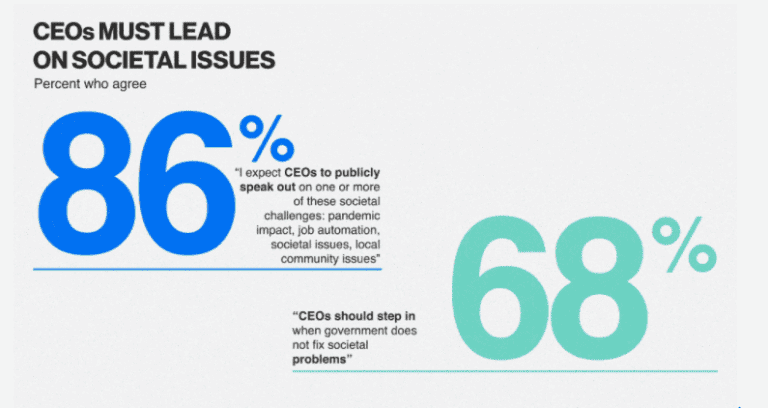
Pulling together related threads around team/community, individual and leadership in this section, it’s easy to see that performance management frameworks will become broader than ever before. How we use the insight and connect it to consumable learning content, mentorship, cultural micro-shifts, and career agility, will become more important than what we measure.
Radical change
Emerging trends that may reshape our work experience & career models
This section imagines how today’s uneven labor market outcomes are producing social fissures that could expand into deeply disruptive waves of radical change – encompassing how we’re educated or trained, how we organize as workers, and how we’re taxed on our work. Later in this section, we’ll look at how we might respond to avert some of the more radical possibilities.
6. Hybrid educators
2020 radically upended the education sector in the same way as the world of work. With tuition fees already deterring many from higher education, the learners who did opt-in have been forced to step away from oft-expensive, outdated university courses or switch to remote-only learning. With the broader university experience very different from what was promised, it is possible that staffing agencies could in the coming years step in as tertiary educators covering a sweep of new occupations.
Especially when targeted at occupations with large undersupply issues, staffing agencies could agree to run large training programs for corporate clients and commit to providing trained employee cohorts within 12-18 months. These programs would have the potential to reduce the debt burden on those just starting out in their careers, by using Income Sharing Agreements to train with the promise of debt-free payback over a minimum period later. Some even foresee how these agreements will blend with ecosystem-based incentives (e.g. if Big Corp’s foundation finances the student’s learning and they go on to work for Big Corp or an affiliate, every $1 shared counts as a $2 repayment). A promising way to help close generational wealth gaps.
Skeptical? Power MBA and Quantic are options already competing with traditional university MBAs within the lucrative executive education marketplace. We already see tech companies opening up training to developer communities who then go on to advocate for their platforms, a signal towards this new approach to talent pipelining. We also see increased interest in reskilling workers displaced from declining industries (these “workforce equity” programs often operate with corporate, government and non-profit input). In my view, we are one tech-powered, capital-intensive staffing agency away from seeing a new ecosystem approach to talent pipelining which ousts the higher education sector from it’s primary role of today.
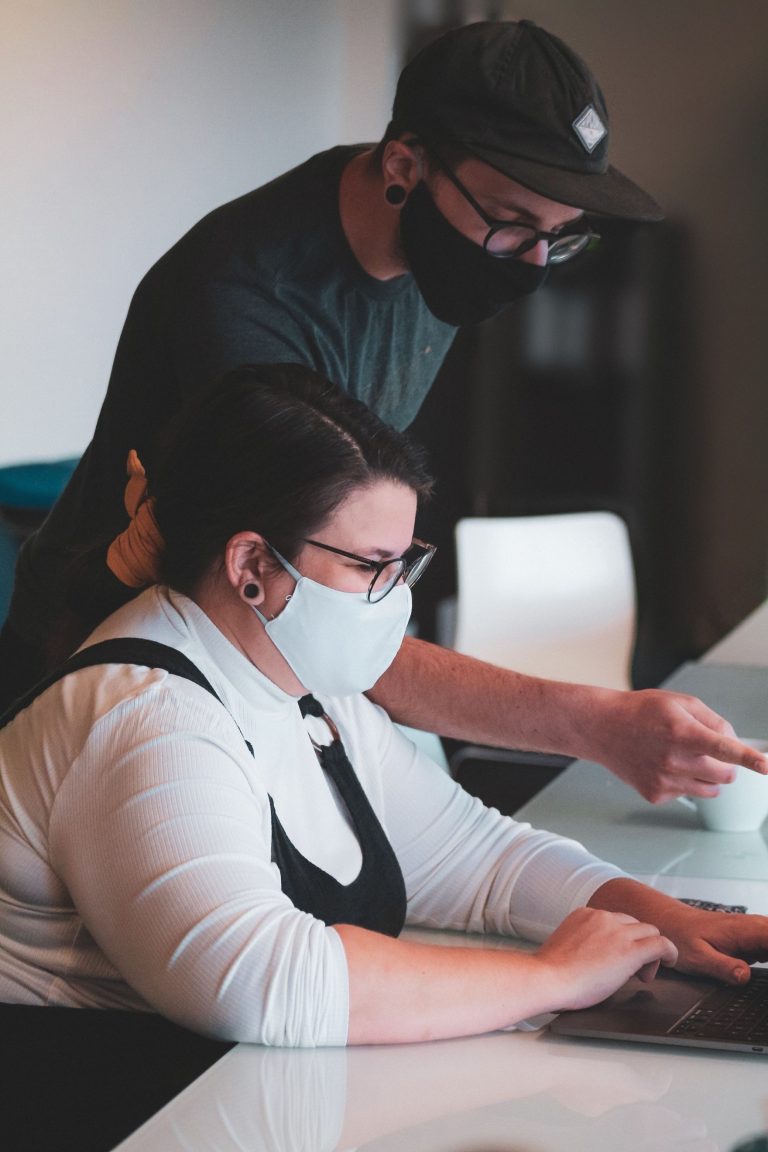
7. Talent "guilds"
If talent acquisition, collaboration and innovation happen embryonically with the help of Hybrid Educators, Talent Agents, CEMs, and Workplace Analytics, could we see eventually see the emergence of self-organized talent communities? Inherently more radical than those above, this trend plays to the growing tide of workplace activism in some sectors (e.g. Google) and concerns regarding how independent/dependent contractors are regulated in a labor market no longer offering the security of a lifetime employment contract.
Along with social drivers, perhaps the biggest enabler of this labor market reconfiguration is the future of corporate real estate. Already underway before the pandemic, as established corporates looked to channel the innovative capacity of communal spaces like WeWork, this trend may intensify as we return to local “hub” workspaces rather than ‘HQs’ in large numbers. As with the guilds of the Middle Ages, hub workspace could see the symbiotic homing of groups challenging the corporate status quo – united in purpose, causes and community ethos.
Stakeholder capitalism may catch up first, but it’s worth reviewing John Hagel’s thoughts on a possible ‘gig to guild shift’ borne out of the desire to learn faster than the corporate workplace experience allows. Before we get to guilds, evolving towards social learning through apps like Clubhouse could further transform our learning experience, whilst continuing the de-coupling of learning from the workplace. “Ted Talks meets Soho House meets your favourite podcast app” is how the Evening Standard aptly puts it – quite the vision. Soar Audio also holds great promise for connected content.
Guild affiliation is, then, a fascinating take on the future of unionism in the world of work. The guild could become the de facto provider of all people related services (hiring, learning, work allocation, performance management) and administer retirement, health and other benefit programs. With such dynamic leverage, guilds could also have wide ranging implications for how work is rewarded (share of capital ownership > wages) and taxed (at the point of capital acquisition > payroll), again showing parallels with guilds of the past. Those are complex policy changes granted, however the advantages for business are also numerous: flexible access to fully-formed teams providing scarce skills at scale, with transaction costs rolled into the price of the job.
If I’ve totally lost you at this point, perhaps a look at the UK’s Beauty Guild will redeem me some confidence. Furthermore, there’s evidence the infrastructure needed to bring common interest groups together beyond organizational boundaries is building with Guild. Granted we’re not talking about a widespread share of paid work, though even a 5-10% shift to guilds would change the landscape – and potentially suit talent within sectors such as web services.
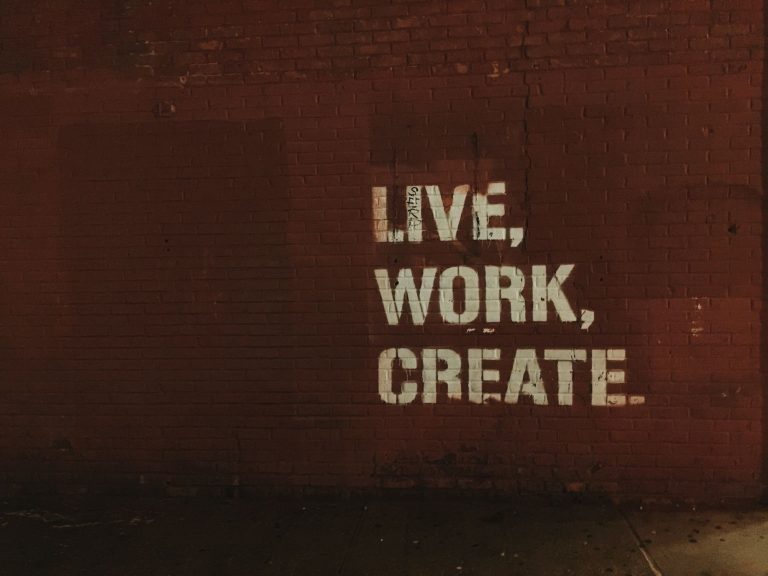
8. New models of taxation
If we see the scaled emerge of talent models anywhere near as radical as guilds, global policymakers will need to respond. Indeed, one could argue this has already started, with regulatory battles raging over gig work in numerous countries (source: Politico). Returning full circle to the problems raised by the detachment of work from time and place at a time when governments are spending record amounts to limit the job losses caused by Covid-19, it’s clear that the trajectory of work will bring profound challenges to our current models of taxation. With states taking a protectionist stance in many industries for the first time in my lifetime (excluding the 2008 financial crises where state support was largely limited to the FS industry) and renewing their commitments to infrastructure spending at levels again not seen in my lifetime, we are facing the perfect storm of drivers towards sweeping economic reform. The extent of it will depend on how much work transitions to gig models which aren’t providing social protections today.
We will see further growth in high skilled jobs as a share of total available (human) work, which will become more distributed than ever. It’s currently common for this type of work to sit largely outside of income tax recovery, within the contingent labor market. In the UK and other developed economies, taxation on contingent labor (though changing with regulations such as IR35) is littered with incentives and mechanisms to reduce reportable income. As systems grow smarter, it may become easier for governments and companies to contextualize benefits and taxation in the jurisdiction a worker is based – and adapt that as the worker moves around. Oyster signals the way as the world’s only remote-first HCM platform – with the vision of making good jobs available anywhere in the world, by making global hiring as easy as local hiring. Imagine what your workplace experience could feel like having integrated of hiring, contracting, onboarding and payroll, for employees and contractors, globally. With $20M Series A funding announced just this month, Oyster’s disruptive potential is growing…
Such ease of contracting talent globally could force a fundamental re-think of the legislative framework around work – and a potential transition from collective to individually-focused agreements (think independent LLP rather than permanent contract). Looking longer-term, we may see a change to how people are compensated for their contribution at work. Influenced by the work of Piketty and others, it is my view that future economies will need to shift towards taxing revenue (where transacted) and capital gains (where IP and digital assets are created or physical assets held) at the point of transaction, as salaries or wages as a form of income diminish in some sectors. In November 2020, I posted on LinkedIn about the potential for Ideation to become a future work paradigm – one in which democratizing the way we build, share, grow and trade intellectual capital could lower the cost of acquisition whilst freeing people to work on purposeful projects in teams they form or join.
Of course, before all of this comes the opportunity to meet the reskilling challenge of today. As the 4th Industrial Revolution takes root and nations once again compete to establish a lead in strategic capabilities (AI, biotechnology, next-gen computing, cybersecurity etc.), policymakers will need to close the skill gap. We’ve seen lots of talk on how we might more effectively tax productive capital and put some of that to work lifting others out of the productivity floor in declining industries. However, returning to the Edelman Trust Barometer findings, the way to get ahead of that sort of change will be to design and deliver reskilling experiences in partnership between governments, NGOs and business. Coal to Code in the US was an early example that has powered an entire industry towards smoother career transitions. Getting those right where we didn’t in the late 20th century would go some way to healing capitalism’s crisis point.
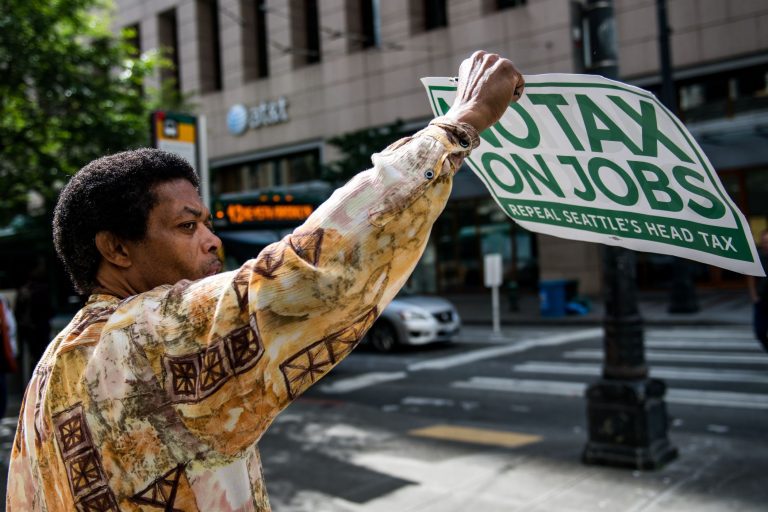
Respond now to avert disruptive potential later
To avert long-term labor market reforms, we should transform the workplace experience by:
- Partnering with staffing agencies to trial new ways of training large cohorts of talent in high-demand occupations
- Improving the speed of learning and job rotation, to avert loss of talent by offering the sort of career agility every generation in the workforce is beginning to crave
- Connecting activist segments of the workforce with social impact programs that reaffirm the purpose of tech for common good
- Partnering with governments and non-profit organizations to bring learning and reskilling programs into industries where workers are suffering job dislocation.
Social fissures demonstrate the need for change, and new workplace experience scenarios begin to show us the way.
Navigate the future of work, on your terms
Covid-19 may not be the sole catalyst of our rapidly evolving workplace experience, but by April 2020 Satya Nadella observed that the pandemic “condensed 2 years of digital transformation into 2 months” (source: Microsoft). Since then, the loss of 255m jobs globally has already left a distorted and uneven impact across countries, sectors and workforce segments. The permanence of hybrid work will ask us to new ways of working, connecting, leading and learning. Improvements to our Workforce Experience not only benefit people now, but can improve our resilience to future shocks. While making the Future of Work inclusive for everyone will ease the blustery headwinds toward more radical reform.
Such a human-centered recovery is easier said than done, though we can think about the evolution along 3 horizons:
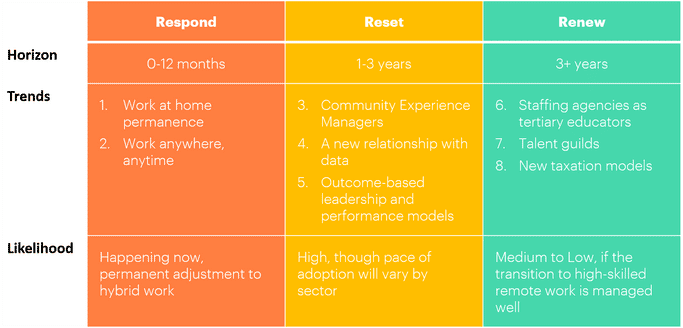
Source: Hipertalent. All rights reserved.
Respond in the short-term
We can continue to shape our response to the pandemic, worker anxieties, and transformed expectations, by:
1. Preparing for work at home permanence by reconfiguring office space to maximize 2-3 days of in-workplace time per week, taking care to personalize a secure return-to-office experience to each generation and using data to improve health monitoring
2. Enabling a work anytime, anywhere experience, with further investment in technology and refinements to culture – trusting people to do the right thing, and using synchronous and asynchronous communications thoughtfully.
Reset in the medium term
We can optimize the hybrid work experience by:
3. Introducing or reshaping ‘Community Experience Managers’ to bridge the physical and digital workplace divide
4. Democratizing workplace measurement as an aid to distributed talent communities, promoting widespread use of AI, intelligent nudges and personal agents across the lifecycle
5. Embracing new leadership and performance expectations at all levels, reflecting the rise of stakeholder capitalism.
Renew in the long-term
Counterbalancing forces are beginning their rise. We should prepare for a more flexible, multi-constituent talent supply chain – driven by skill shortages, changing worker preferences and assertive workplace activism. Good experiments might involve:
6. Collaborating with staffing agencies as tertiary educators for in-demand occupations
7. Improving the speed of learning and promoting career agility, to offset the potential rise of self-organizing groups (or guilds)
8. Evolving systems to meet the new prevalence of remote working, while anticipating new taxation models and potential routes to reduced capital acquisition costs.
In short, we are heading towards new terms of worker engagement: when, where and how the worker wants. And we’re doing so up to 20 years earlier than some predicted!
There has never been a more exciting time to reframe workplace experiences across cultural, technological, physical, emotional, intellectual and financial dimensions. I look forward to joining you on the journey.
With optimism,
GM
February 2021


